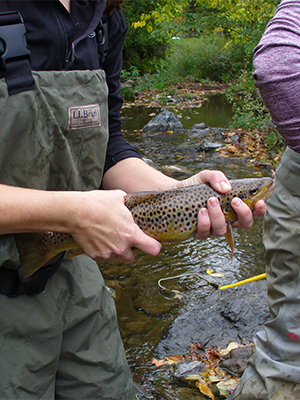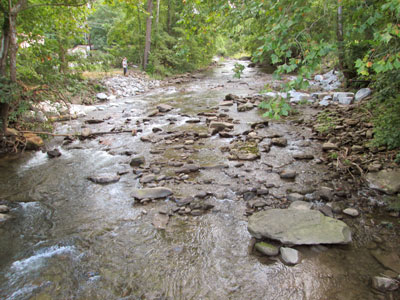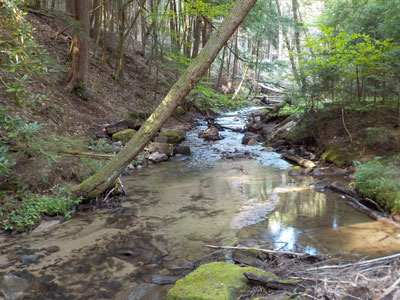Watershed Conservation
Aquatic Connectivity and Species Passage
Pennsylvania’s rivers and streams have been conduits for humans since Native Americans first used trails along river bottoms to travel across the Commonwealth. As the state became more developed, infrastructure increased including roads, bridges, culverts and dams.

These improvements increased the ability to transport natural resources, such as timber and coal, with inadequate planning or provisions for aquatic resources including native trout, freshwater mussels and hellbenders.
As a result, this has led to fragmented watersheds, which disrupt natural pathways for the movement of aquatic organisms, reduce sediment and woody debris transport and require routine maintenance for the owners of roads. The Western Pennsylvania Conservancy’s watershed conservation staff work to assess problematic barriers to aquatic organism passage.
With the help of volunteers and community, state and federal partners, we identify undersized or inadequate culverts and dilapidated dams, and work with the owner and our partners to complete projects that restore passage for aquatic organisms. Our work still maintains transportation needs and access. WPC uses the North Atlantic Aquatic Connectivity Collaborative protocol, standardized set of protocols and procedures to help evaluate, prioritize and assess connectivity issues in waterways and watersheds.
In many instances, removing dams and replacing culverts significantly improve fish populations and species diversity, which are important to the health of the waterway and long-term species survival rates. This work is vital, not only for the health of aquatic life and dependent ecosystems, but for Pennsylvania’s outdoor recreation industry that depends on healthy and thriving waterways for fishing. Examples of our efforts across the region to remove barriers and improve to aquatic habitats follow:
Dunbar Dam Removal
 In cooperation with our partners Pennsylvania Game Commission and American Rivers, we recently removed multiple dams on Dunbar Creek, a 12.6-mile-long stream in Fayette County, which is a tributary of the Youghiogheny River. The project removed four dams within SGL 51, and decommissioned an abandon water utility-line that had created a passage barrier just above the town of Dunbar. Through the completion of this project, more than 55 miles of Dunbar Creek and its tributaries are now reconnected with the Youghiogheny River, creating an entirely free flowing stream system for the first time in more than 100 years! Along with the dam removals, extensive work was completed to fully reconnect the stream with its historic floodplains in this high-quality watershed.
In cooperation with our partners Pennsylvania Game Commission and American Rivers, we recently removed multiple dams on Dunbar Creek, a 12.6-mile-long stream in Fayette County, which is a tributary of the Youghiogheny River. The project removed four dams within SGL 51, and decommissioned an abandon water utility-line that had created a passage barrier just above the town of Dunbar. Through the completion of this project, more than 55 miles of Dunbar Creek and its tributaries are now reconnected with the Youghiogheny River, creating an entirely free flowing stream system for the first time in more than 100 years! Along with the dam removals, extensive work was completed to fully reconnect the stream with its historic floodplains in this high-quality watershed.
Johns Run Dam Removal
 During the summer of 2018, a small crew of WPC staff and partners removed a log and stone dam with hand tools on Johns Run in Jefferson County. Johns Run is a tributary to Callen Run in the larger Clarion River watershed. The elimination of this barrier reconnected 4.75 miles of upstream habitat, allowing three species of native fish to once again move freely between Johns and Callen Runs. WPC continues to work with 15 separate agencies and organizations to increase connectivity between Callen Run and the Clarion River ecosystem, where ten additional fish species have been “dammed out” of its high quality waters for more than 150 years. Metal “scrap” materials from the Johns Run dam removal were donated to the Brockway Center for Arts and Technology, a local non-profit that provides job training to rural unemployed and underemployed adults and inspires youth through the arts.
During the summer of 2018, a small crew of WPC staff and partners removed a log and stone dam with hand tools on Johns Run in Jefferson County. Johns Run is a tributary to Callen Run in the larger Clarion River watershed. The elimination of this barrier reconnected 4.75 miles of upstream habitat, allowing three species of native fish to once again move freely between Johns and Callen Runs. WPC continues to work with 15 separate agencies and organizations to increase connectivity between Callen Run and the Clarion River ecosystem, where ten additional fish species have been “dammed out” of its high quality waters for more than 150 years. Metal “scrap” materials from the Johns Run dam removal were donated to the Brockway Center for Arts and Technology, a local non-profit that provides job training to rural unemployed and underemployed adults and inspires youth through the arts.
Morrison Run Dam Removal
Morrison Run is a naturally reproducing native trout stream within the Allegheny National Forest. In 2014, Conservancy staff began a successful multi-year effort with the U.S. Forest Service, Pennsylvania Fish and Boat Commission and Trout Unlimited. This effort replaced a culvert with a bridge and removed a dam to install an in-stream rock ramp. These barriers were removed to improve fish and aquatic organism passage in the stream.
Although this project is completed, our ongoing work to assess improvements to aquatic habitats takes our scientists back to Morrison Run regularly to collect data and conduct fish sampling and other research.
For More Information:
Watershed Conservation Program
Western Pennsylvania Conservancy
1067 Philadelphia Street, Suite 101
Indiana, PA 15701
